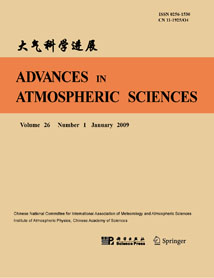| [1] |
ZHANG Ning, ZHU Lianfang, ZHU Yan,
2011: Urban Heat Island and Boundary Layer Structures under Hot Weather Synoptic Conditions: A Case Study of Suzhou City, China, ADVANCES IN ATMOSPHERIC SCIENCES, 28, 855-865.
doi: 10.1007/s00376-010-0040-1
|
| [2] |
JIANG Dabang, YU Ge, ZHAO Ping, CHEN Xing, LIU Jian, LIU Xiaodong, WANG Shaowu, ZHANG Zhongshi, YU Yongqiang, LI Yuefeng, JIN Liya, XU Ying, JU Lixia, ZHOU Tianjun, YAN Xiaodong,
2015: Paleoclimate Modeling in China: A Review, ADVANCES IN ATMOSPHERIC SCIENCES, 32, 250-275.
doi: 10.1007/s00376-014-0002-0
|
| [3] |
GUO Xueliang, FU Danhong, LI Xingyu, HU Zhaoxia, LEI Henchi, XIAO Hui, HONG Yanchao,
2015: Advances in Cloud Physics and Weather Modification in China, ADVANCES IN ATMOSPHERIC SCIENCES, 32, 230-249.
doi: 10.1007/s00376-014-0006-9
|
| [4] |
Tang Youhua, Miao Manqian,
1998: Numerical Studies on Urban Heat Island Associated with Urbanization in Yangtze Delta Region, ADVANCES IN ATMOSPHERIC SCIENCES, 15, 393-403.
doi: 10.1007/s00376-998-0009-5
|
| [5] |
YANG Shili, FENG Jinming, DONG Wenjie, CHOU Jieming,
2014: Analyses of Extreme Climate Events over China Based on CMIP5 Historical and Future Simulations, ADVANCES IN ATMOSPHERIC SCIENCES, 31, 1209-1220.
doi: 10.1007/s00376-014-3119-2
|
| [6] |
Athanassios A. ARGIRIOU, Zhen LI, Vasileios ARMAOS, Anna MAMARA, Yingling SHI, Zhongwei YAN,
2023: Homogenised Monthly and Daily Temperature and Precipitation Time Series in China and Greece since 1960, ADVANCES IN ATMOSPHERIC SCIENCES, 40, 1326-1336.
doi: 10.1007/s00376-022-2246-4
|
| [7] |
Kyu Rang KIM, Tae Heon KWON, Yeon-Hee KIM, Hae-Jung KOO, Byoung-Cheol CHOI, Chee-Young CHOI,
2009: Restoration of an Inner-City Stream and Its Impact on Air Temperature and Humidity Based on Long-Term Monitoring Data, ADVANCES IN ATMOSPHERIC SCIENCES, 26, 283-292.
doi: 10.1007/s00376-009-0283-x
|
| [8] |
REN Guoyu, DING Yihui, ZHAO Zongci, ZHENG Jingyun, WU Tongwen, TANG Guoli, XU Ying,
2012: Recent Progress in Studies of Climate Change in China, ADVANCES IN ATMOSPHERIC SCIENCES, 29, 958-977.
doi: 10.1007/s00376-012-1200-2
|
| [9] |
Zhen LI, Zhongwei YAN, Lijuan CAO, Phil D. JONES,
2018: Further-Adjusted Long-Term Temperature Series in China Based on MASH, ADVANCES IN ATMOSPHERIC SCIENCES, 35, 909-917.
doi: 10.1007/s00376-018-7280-x
|
| [10] |
WANG Shaowu, ZHU Jinhong, CAI Jingning,
2004: Interdecadal Variability of Temperature and Precipitation in China since 1880, ADVANCES IN ATMOSPHERIC SCIENCES, 21, 307-313.
doi: 10.1007/BF02915560
|
| [11] |
GE Quansheng, WANG Shaowu, WEN Xinyu, Caiming SHEN, HAO Zhixin,
2007: Temperature and Precipitation Changes in China During the HoloceneTemperature and Precipitation Changes in China During the Holocene, ADVANCES IN ATMOSPHERIC SCIENCES, 24, 1024-1036.
doi: 10.1007/s00376-007-1024-7
|
| [12] |
SONG Lianchun, A. J. CANNON, P. H. WHITFIELD,
2007: Changes in Seasonal Patterns of Temperature and Precipitation in China During 1971--2000, ADVANCES IN ATMOSPHERIC SCIENCES, 24, 459-473.
doi: 10.1007/s00376-007-0459-1
|
| [13] |
XU Ying, GAO Xuejie, SHEN Yan, XU Chonghai, SHI Ying, F. GIORGI,
2009: A Daily Temperature Dataset over China and Its Application in Validating a RCM Simulation, ADVANCES IN ATMOSPHERIC SCIENCES, 26, 763-772.
doi: 10.1007/s00376-009-9029-z
|
| [14] |
DONG Siyan, XU Ying, ZHOU Botao, SHI Ying,
2015: Assessment of Indices of Temperature Extremes Simulated by Multiple CMIP5 Models over China, ADVANCES IN ATMOSPHERIC SCIENCES, 32, 1077-1091.
doi: 10.1007/s00376-015-4152-5
|
| [15] |
Quansheng GE, Haolong LIU, Xiang MA, Jingyun ZHENG, Zhixin HAO,
2017: Characteristics of Temperature Change in China over the Last 2000 years and Spatial Patterns of Dryness/Wetness during Cold and Warm Periods, ADVANCES IN ATMOSPHERIC SCIENCES, 34, 941-951.
doi: 10.1007/s00376-017-6238-8
|
| [16] |
TIAN Di, GUO Yan*, DONG Wenjie,
2015: Future Changes and Uncertainties in Temperature and Precipitation over China Based on CMIP5 Models, ADVANCES IN ATMOSPHERIC SCIENCES, 32, 487-496.
doi: 10.1007/s00376-014-4102-7
|
| [17] |
Ying XU, Xuejie GAO, Filippo GIORGI, Botao ZHOU, Ying SHI, Jie WU, Yongxiang ZHANG,
2018: Projected Changes in Temperature and Precipitation Extremes over China as Measured by 50-yr Return Values and Periods Based on a CMIP5 Ensemble, ADVANCES IN ATMOSPHERIC SCIENCES, 35, 376-388.
doi: 10.1007/s00376-017-6269-1
|
| [18] |
Guwei ZHANG, Gang ZENG, Xiaoye YANG, Zhihong JIANG,
2021: Future Changes in Extreme High Temperature over China at 1.5°C–5°C Global Warming Based on CMIP6 Simulations, ADVANCES IN ATMOSPHERIC SCIENCES, 38, 253-267.
doi: 10.1007/s00376-020-0182-8
|
| [19] |
GUO Yanjun, DING Yihui,
2011: Impacts of Reference Time Series on the Homogenization of Radiosonde Temperature, ADVANCES IN ATMOSPHERIC SCIENCES, 28, 1011-1022.
doi: 10.1007/s00376-010-9211-3
|
| [20] |
HAN Guijun, LI Wei, ZHANG Xuefeng, LI Dong, HE Zhongjie, WANG Xidong, WU Xinrong, YU Ting, MA Jirui,
2011: A Regional Ocean Reanalysis System for Coastal Waters of China and Adjacent Seas, ADVANCES IN ATMOSPHERIC SCIENCES, 28, 682-690.
doi: 10.1007/s00376-010-9184-2
|















 AAS Website
AAS Website 
 AAS WeChat
AAS WeChat 
 DownLoad:
DownLoad: